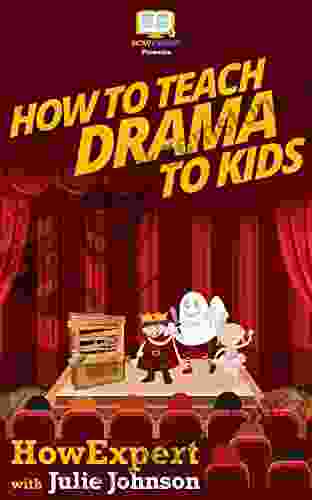How to Teach Drama to Kids: A Comprehensive Guide for Educators

Drama is an invaluable tool for educating children. It fosters creativity, imagination, confidence, and a wide range of other essential life skills. However, teaching drama to kids can be a daunting task, especially for those without a background in the performing arts. This comprehensive guide will provide educators with everything they need to know to engage and inspire young learners through the transformative power of drama.
The benefits of teaching drama to kids are numerous and far-reaching. Here are just a few:
- Enhances Creativity and Imagination: Drama encourages children to think outside the box, explore different perspectives, and express themselves creatively.
- Develops Confidence and Self-Esteem: Performing in front of an audience can be nerve-wracking, but it also helps children build confidence in themselves and their abilities.
- Improves Communication and Language Skills: Drama activities require children to use their voices, bodies, and imaginations to communicate effectively. This enhances their verbal and nonverbal language skills.
- Cultivates Teamwork and Collaboration: Working together on a drama project teaches children the importance of cooperation, listening to others, and respecting different ideas.
- Provides an Emotional Outlet: Drama allows children to explore and express their emotions in a safe and controlled environment. This can help them develop emotional intelligence and cope with challenging situations.
To get started teaching drama to kids, you don't need any elaborate resources or fancy equipment. All you need is a willingness to play, explore, and share with your students.
4 out of 5
| Language | : | English |
| File size | : | 5096 KB |
| Text-to-Speech | : | Enabled |
| Screen Reader | : | Supported |
| Enhanced typesetting | : | Enabled |
| Word Wise | : | Enabled |
| Print length | : | 120 pages |
| Lending | : | Enabled |
- Start with Simple Games: Begin with fun and engaging drama games to warm up and encourage creativity.
- Create a Safe and Supportive Environment: Make sure your students feel comfortable and respected in your drama class.
- Let Students Explore: Encourage your students to try different roles, voices, and characters. Let their imaginations run wild.
- Use Props and Costumes: Props and costumes can help children bring their characters to life and enhance the drama experience.
- Provide Constructive Feedback: Offer positive and helpful feedback to your students, focusing on their strengths and areas for improvement.
Planning engaging and educational drama lessons is essential for successful teaching. Here are some tips:
- Set Clear Learning Objectives: Determine what you want your students to learn from each lesson.
- Choose Age-Appropriate Activities: Adapt activities to the developmental level and interests of your students.
- Incorporate Multiple Skills: Include activities that develop different skills, such as communication, creativity, and teamwork.
- Provide Variety: Offer a range of activities, including improvisation games, storytelling, role-playing, and script work.
- Encourage Student Participation: Give every student a chance to participate and voice their ideas.
The approach to teaching drama should vary depending on the age group of your students. Here are some guidelines:
Preschool and Kindergarten:
- Focus on imaginative play and storytelling.
- Use simple props and costumes.
- Keep activities short and engaging.
Elementary School:
- Introduce basic acting techniques and improvisation.
- Encourage students to work together on projects.
- Provide opportunities for performance.
Middle School:
- Explore more advanced acting techniques, such as character development and script analysis.
- Encourage students to develop their own plays and performances.
- Provide opportunities for collaboration with other classes.
High School:
- Offer specialized drama electives, such as acting, directing, and technical theater.
- Allow students to take on leadership roles in productions.
- Encourage students to pursue drama beyond the classroom.
Assessing students' progress in drama is an important part of teaching. Here are some effective methods:
- Observation: Observe students' participation, creativity, and communication skills during activities.
- Performances: Evaluate students' performances in class presentations or productions.
- Self-Reflection: Ask students to reflect on their own learning and progress.
- Feedback from Peers: Encourage students to provide constructive feedback to each other.
- Portfolio Development: Have students collect and showcase their work, including scripts, character sketches, and performance evaluations.
There are numerous resources available to support drama educators. Here are a few:
- Drama Organizations: Join organizations like the Drama Teachers Association (DTA) and the American Alliance for Theatre Education (AATE).
- Workshops and Training: Attend workshops and professional development opportunities to enhance your teaching skills.
- Online Resources: Explore online resources, such as the DTA website and the National Endowment for the Arts toolkit for drama education.
- Collaboration with Other Educators: Connect with other drama teachers and share ideas and resources.
Teaching drama to kids is an incredibly rewarding experience that fosters creativity, communication, confidence, and a range of other essential life skills. By following the guidelines and tips outlined in this comprehensive guide, educators can empower their students to explore their imaginations, express themselves freely, and develop a deep appreciation for the transformative power of the performing arts. Remember, the most important aspect of teaching drama to kids is to create a fun, supportive, and engaging learning environment where every student feels valued and inspired to unleash their inner artist.
4 out of 5
| Language | : | English |
| File size | : | 5096 KB |
| Text-to-Speech | : | Enabled |
| Screen Reader | : | Supported |
| Enhanced typesetting | : | Enabled |
| Word Wise | : | Enabled |
| Print length | : | 120 pages |
| Lending | : | Enabled |
Do you want to contribute by writing guest posts on this blog?
Please contact us and send us a resume of previous articles that you have written.
 Best Book
Best Book Page Flip
Page Flip Bookshelf
Bookshelf Literary loom
Literary loom Chapter
Chapter Bookish
Bookish PageTurner
PageTurner Bibliophile
Bibliophile Story
Story Inkwell
Inkwell Bookworm
Bookworm Labyrinth
Labyrinth Plot Twist
Plot Twist Prose
Prose Paperback
Paperback Storyteller
Storyteller Sanctuary
Sanctuary Fiction
Fiction Reading
Reading Chronicle
Chronicle Read
Read Richard D Fisher
Richard D Fisher Ursa Dax
Ursa Dax Q David Bowers
Q David Bowers Robert Finch
Robert Finch Donna Williams
Donna Williams Jenny Bowen
Jenny Bowen Martha Hall Kelly
Martha Hall Kelly Sally Blake
Sally Blake Tim Anderson
Tim Anderson Miriam Giguere
Miriam Giguere Yuko Green
Yuko Green Lisa Brahin
Lisa Brahin S G Seabourne
S G Seabourne Warren Dotz
Warren Dotz Mimi Grace
Mimi Grace William Gibson
William Gibson 1st Edition Kindle Edition
1st Edition Kindle Edition Mary Stuart
Mary Stuart Joe Kuster
Joe Kuster Walter Mosley
Walter Mosley Sam Crescent
Sam Crescent Jerzy Kosinski
Jerzy Kosinski Russell Zimmerman
Russell Zimmerman Matt Gilbert
Matt Gilbert Ton Viet Ta
Ton Viet Ta Carly Murden
Carly Murden Victor Steffensen
Victor Steffensen Kyriacos C Markides
Kyriacos C Markides Jim Santos
Jim Santos Tony Morgan
Tony Morgan Timothy S Susanin
Timothy S Susanin Toni Morrison
Toni Morrison David Baldacci
David Baldacci Kim Catron
Kim Catron Roger Cowell
Roger Cowell Lindy Viandier
Lindy Viandier Jonah Mcdonald
Jonah Mcdonald Nancy Princenthal
Nancy Princenthal Raquel Cepeda
Raquel Cepeda Matthew Israel
Matthew Israel Miriam F Williams
Miriam F Williams Sonia Moore
Sonia Moore Jesse Thistle
Jesse Thistle John Dvorak
John Dvorak S L Osborne
S L Osborne Malcolm C Salaman
Malcolm C Salaman Christian Blauvelt
Christian Blauvelt James Hall
James Hall Joyce Roa
Joyce Roa Connie Easton
Connie Easton Megan Goldmine
Megan Goldmine Kathryn Aalto
Kathryn Aalto M A Rothman
M A Rothman Julie Yip Williams
Julie Yip Williams Holly Madison
Holly Madison Bernadette Simpson
Bernadette Simpson Lisa Congdon
Lisa Congdon Nadia Owusu
Nadia Owusu Kate Bryan
Kate Bryan Regina Clarke
Regina Clarke Helm Wotzkow
Helm Wotzkow Wallace Terry
Wallace Terry Milind Mulick
Milind Mulick Magdalena Matulewicz
Magdalena Matulewicz Marcy Conway
Marcy Conway Joyce Huber
Joyce Huber Richard J Powell
Richard J Powell Daniel Gibbs
Daniel Gibbs Oprah Winfrey
Oprah Winfrey Meniere Man
Meniere Man Kindle Comixology
Kindle Comixology Blair Davis
Blair Davis Taniela Tabu
Taniela Tabu John Donohue
John Donohue Lisa Smith
Lisa Smith Mary Carolyn Waldrep
Mary Carolyn Waldrep Tova Rabinowitz
Tova Rabinowitz Paige R Penland
Paige R Penland Norman Lebrecht
Norman Lebrecht William Evans
William Evans Russ Howard
Russ Howard Paul Greenhalgh
Paul Greenhalgh Tony Walsh
Tony Walsh Loung Ung
Loung Ung Tom Larcombe
Tom Larcombe Sharmila Sen
Sharmila Sen Renia Spiegel
Renia Spiegel Mike Joyce
Mike Joyce Joann Perahia
Joann Perahia Nathan Mccall
Nathan Mccall Sam Shepard
Sam Shepard Lynn Garafola
Lynn Garafola Jeff Mellem
Jeff Mellem Travis Bagwell
Travis Bagwell Philip Lee
Philip Lee Anne Manera
Anne Manera Mark C Childs
Mark C Childs Jim Forest
Jim Forest Tanja Jung
Tanja Jung David J Schmidt
David J Schmidt Deaver Brown
Deaver Brown Patti Bellantoni
Patti Bellantoni Rayna Denison
Rayna Denison Ben Box
Ben Box Richard W Pointer
Richard W Pointer Ashley Jaquavis
Ashley Jaquavis Caroline Eden
Caroline Eden Lisa See
Lisa See T Stonefield
T Stonefield Momtaz Begum Hossain
Momtaz Begum Hossain Linda Keteyian
Linda Keteyian Janice Tingum
Janice Tingum Nicole Pivirotto
Nicole Pivirotto Kim Barker
Kim Barker Richard Fleischer
Richard Fleischer Tom Cotter
Tom Cotter Kelly Gay
Kelly Gay Rachel Shirley
Rachel Shirley Tonya Burrows
Tonya Burrows Jonathan Smidt
Jonathan Smidt Monica Huerta
Monica Huerta Louis L Amour
Louis L Amour Michael R Jackson
Michael R Jackson Paul Chiasson
Paul Chiasson Vicki Rozema
Vicki Rozema Jessica Garrison
Jessica Garrison Lesley Riley
Lesley Riley Mayukh Sen
Mayukh Sen Laurinda Reddig
Laurinda Reddig Andrew Cunningham
Andrew Cunningham Tom Fay
Tom Fay Tim Testu
Tim Testu Nien Cheng
Nien Cheng Skip Mort
Skip Mort Stephanie Nicole Norris
Stephanie Nicole Norris Mark Lane
Mark Lane Molly Haskell
Molly Haskell Rick Goldschmidt
Rick Goldschmidt Pat Dews
Pat Dews Jeff W Bens
Jeff W Bens Scott Brown
Scott Brown Stefan Pabst
Stefan Pabst Chika Okeke Agulu
Chika Okeke Agulu Sonja Mejcher Atassi
Sonja Mejcher Atassi Daniel Silva
Daniel Silva Mladen Sutej
Mladen Sutej Sarah Abrevaya Stein
Sarah Abrevaya Stein Wesley Gardner
Wesley Gardner William Lidwell
William Lidwell Sally Howard
Sally Howard Lauren Scruggs
Lauren Scruggs Tom Sito
Tom Sito Nathan Riley
Nathan Riley Phoenix Grey
Phoenix Grey Tasha Black
Tasha Black Patrick Mcgilligan
Patrick Mcgilligan Tiya Rayne
Tiya Rayne Steven G Krantz
Steven G Krantz Philip Ball
Philip Ball Tyora Moody
Tyora Moody Taylor Mason
Taylor Mason Roland L Mcintosh
Roland L Mcintosh Mark T Conard
Mark T Conard Priscilla Batzell
Priscilla Batzell Sesali Bowen
Sesali Bowen Ilana Benady
Ilana Benady Philippa Ballantine
Philippa Ballantine Joshua James
Joshua James Oscar Owen
Oscar Owen Clara Nieto
Clara Nieto Robert M Goldstein
Robert M Goldstein John Muir
John Muir Kitty Williams
Kitty Williams Rem Koolhaas
Rem Koolhaas Richard Butner
Richard Butner Svenja Reidelbach
Svenja Reidelbach Regine Abel
Regine Abel Paul Noble
Paul Noble Learning Through Play
Learning Through Play Ed Gillis
Ed Gillis Madhushree Ghosh
Madhushree Ghosh William W Johnstone
William W Johnstone Margaret Eggleton
Margaret Eggleton James Hunter
James Hunter Margaret C Collier
Margaret C Collier Michael Smith
Michael Smith I C Robledo
I C Robledo Brenda Lyons
Brenda Lyons Ward Eister
Ward Eister Laura Reiter
Laura Reiter Mahi Wasfy
Mahi Wasfy Ryan Roenfeld
Ryan Roenfeld Marcello Di Cintio
Marcello Di Cintio Requiem Scolopendra
Requiem Scolopendra Molly Bang
Molly Bang Don Peri
Don Peri Nolan Clark
Nolan Clark Suzanne Fredericq
Suzanne Fredericq Stuart Douglas
Stuart Douglas Sheila Watt Cloutier
Sheila Watt Cloutier Steve Alpert
Steve Alpert Johno Ellison
Johno Ellison Robert B Parker
Robert B Parker Manifestation Publishing House
Manifestation Publishing House Xander Boyce
Xander Boyce Mick Huerta
Mick Huerta Aer Ki Jyr
Aer Ki Jyr Honesty Price
Honesty Price James J Downes
James J Downes Kerry Bogert
Kerry Bogert Renee Rose
Renee Rose Shani Greene Dowdell
Shani Greene Dowdell Tricia Rose
Tricia Rose Paul Seydor
Paul Seydor Joy Horowitz
Joy Horowitz Bernth Lindfors
Bernth Lindfors William L Fox
William L Fox Elle Wright
Elle Wright Sergio Toppi
Sergio Toppi Richard Ross
Richard Ross Kimberly Smith
Kimberly Smith Ari Goldberg
Ari Goldberg Lauren Beukes
Lauren Beukes W R Tymms
W R Tymms Omar Sharif Jr
Omar Sharif Jr Philip K Dick
Philip K Dick Steven W Naifeh
Steven W Naifeh Deborah Fallows
Deborah Fallows Mimi Thorisson
Mimi Thorisson Karma Waltonen
Karma Waltonen Giovanni Iannoni
Giovanni Iannoni Tom Brosnahan
Tom Brosnahan Larry Taylor
Larry Taylor Joseph Toone
Joseph Toone Paul Strathern
Paul Strathern Daniel James Brown
Daniel James Brown Maria Morera Johnson
Maria Morera Johnson Lauren Graham
Lauren Graham Steve Cohen
Steve Cohen Vic Shayne
Vic Shayne Marteeka Karland
Marteeka Karland Matthew Bourne
Matthew Bourne Luke Chmilenko
Luke Chmilenko W Somerset Maugham
W Somerset Maugham Sangeeta Prasad
Sangeeta Prasad Ken Budd
Ken Budd Tracy Lash Decrosta
Tracy Lash Decrosta Michael F Steltenkamp
Michael F Steltenkamp Paolo Bacigalupi
Paolo Bacigalupi William C Cline
William C Cline Tony Dungy
Tony Dungy Kenan Trebincevic
Kenan Trebincevic Bill Arnott
Bill Arnott Sally J Pla
Sally J Pla Ruth Reichl
Ruth Reichl Marlena De Blasi
Marlena De Blasi Korani Connolly
Korani Connolly Ruby Dixon
Ruby Dixon Hope Edelman
Hope Edelman Diana Kupershmit
Diana Kupershmit Katy Sprinkel
Katy Sprinkel Peter L Phillips
Peter L Phillips John Thompson
John Thompson Jenny Lawson
Jenny Lawson Paul A Moua
Paul A Moua Theo Hodges
Theo Hodges Pauli Murray
Pauli Murray Mark Padilla
Mark Padilla Megan Wells
Megan Wells John Paul Stonard
John Paul Stonard Harold Green Iii
Harold Green Iii Jonathan D Sarna
Jonathan D Sarna Graham Cole
Graham Cole Platte Productions Llc
Platte Productions Llc Katharine Branning
Katharine Branning Veronica G Henry
Veronica G Henry Joel Sonnenberg
Joel Sonnenberg Vowron Prime
Vowron Prime Richard S Dunn
Richard S Dunn Nicholas Wapshott
Nicholas Wapshott Natalie Hodges
Natalie Hodges Didier Ghez
Didier Ghez David Hopkins
David Hopkins Victoria Rivera Mckinley
Victoria Rivera Mckinley Naveed Rouhani
Naveed Rouhani Stephen Coles
Stephen Coles W Kamau Bell
W Kamau Bell Vaughn Heppner
Vaughn Heppner Robert Gottlieb
Robert Gottlieb Shaopeng Chen
Shaopeng Chen Talk In Italian
Talk In Italian Akire C
Akire C Mary M Lane
Mary M Lane K Alex Walker
K Alex Walker Julia Fowler
Julia Fowler Liz Scheier
Liz Scheier Pilar M Herr
Pilar M Herr Tom Sterling
Tom Sterling Michelle Jackson
Michelle Jackson Liz Chaderton
Liz Chaderton Bruce Spydar
Bruce Spydar Tammy Ruggles
Tammy Ruggles Stephen Kirkpatrick
Stephen Kirkpatrick Samra Habib
Samra Habib Print Replica Kindle Edition
Print Replica Kindle Edition Various
Various Jessica Fanigliulo
Jessica Fanigliulo John Wesley Powell
John Wesley Powell Stan Tekiela
Stan Tekiela Michael Psellus
Michael Psellus Richard Lippe
Richard Lippe Odie Hawkins
Odie Hawkins Robin Rainbow Gate
Robin Rainbow Gate Liz Hurley
Liz Hurley Tanya Talaga
Tanya Talaga Rebecca Kobrin
Rebecca Kobrin Silvana Paternostro
Silvana Paternostro Shelly Kim
Shelly Kim Richard Matheson
Richard Matheson Kristina Mcmorris
Kristina Mcmorris Julia Summerfield
Julia Summerfield Johanna Lehner
Johanna Lehner Shani Mootoo
Shani Mootoo Jl Seegars
Jl Seegars Russell Means
Russell Means N K Jemisin
N K Jemisin Anne H Berry
Anne H Berry Noah Hurowitz
Noah Hurowitz Grace Lee Boggs
Grace Lee Boggs Krystyna Chiger
Krystyna Chiger Tobias Zimmermann
Tobias Zimmermann Rosemary Mahoney
Rosemary Mahoney Kenneth Laws
Kenneth Laws Letitia Shelton
Letitia Shelton W Glenn Griffin
W Glenn Griffin Margo Bond Collins
Margo Bond Collins 1st Ed 2019 Edition Kindle Edition
1st Ed 2019 Edition Kindle Edition Myrnoska Scott
Myrnoska Scott Robyn Carr
Robyn Carr Steve Gordon Jr
Steve Gordon Jr Joseph Judson Dimock
Joseph Judson Dimock Laura Lee Fritz
Laura Lee Fritz David Roberts
David Roberts Svetlana Quindt
Svetlana Quindt Shelley Shepard Gray
Shelley Shepard Gray Lucy Moore
Lucy Moore Richard Delacy
Richard Delacy Pamela Cutter
Pamela Cutter Michael Friel
Michael Friel Nicki Thornton
Nicki Thornton Lou Darvas
Lou Darvas Lincoln Michel
Lincoln Michel Simon R Green
Simon R Green Thibault Ehrengardt
Thibault Ehrengardt Mark Strand
Mark Strand John Fabian Carlson
John Fabian Carlson Ping Fu
Ping Fu Tim Moss
Tim Moss Mau Kun Yim
Mau Kun Yim Elliot Beier
Elliot Beier Julian May
Julian May Kennedy Ryan
Kennedy Ryan Peter Bone
Peter Bone Manuel Huitzilli
Manuel Huitzilli Jubilee Brown
Jubilee Brown Emma Dabiri
Emma Dabiri Calum Best
Calum Best Martina Carracedo
Martina Carracedo Kim Kavin
Kim Kavin Violet Ramis Stiel
Violet Ramis Stiel Matthew Hahn
Matthew Hahn William Carroll
William Carroll Dean Koontz
Dean Koontz Burst Books
Burst Books Sean Platt
Sean Platt Marie Mutsuki Mockett
Marie Mutsuki Mockett Graeme Swann
Graeme Swann David Kadavy
David Kadavy Trova Heffernan
Trova Heffernan Brian Kevin
Brian Kevin Mary Breu
Mary Breu Sherri Granato
Sherri Granato Megan Marshall
Megan Marshall Mike Lowery
Mike Lowery Rajat Gupta
Rajat Gupta Dave Brett
Dave Brett Rebecca Roanhorse
Rebecca Roanhorse Monica L Miller
Monica L Miller Patty A Wilson
Patty A Wilson Stephen King
Stephen King Alicia Beckton
Alicia Beckton Kassia St Clair
Kassia St Clair John Davidson
John Davidson Daniel Connolly
Daniel Connolly Tamsin Ley
Tamsin Ley Matthew Stavros
Matthew Stavros Neil Fontaine
Neil Fontaine Zondervan
Zondervan David Batchelor
David Batchelor Paul Thimou
Paul Thimou Julian Rothenstein
Julian Rothenstein Marc Cameron
Marc Cameron Paula Henriksen
Paula Henriksen Philip Stewart
Philip Stewart Bob Santos
Bob Santos Eliot Schrefer
Eliot Schrefer Dk Eyewitness
Dk Eyewitness Robin Hobb
Robin Hobb Francis Tipene
Francis Tipene Margo Jefferson
Margo Jefferson Nicholas Sparks
Nicholas Sparks Christopher Lane
Christopher Lane Martin Gardner
Martin Gardner Mariam Elias
Mariam Elias Shlomo Avineri
Shlomo Avineri Robert Henri
Robert Henri Joseph Beuys
Joseph Beuys Karl Ove Knausgaard
Karl Ove Knausgaard Roger Zelazny
Roger Zelazny Yatir Nitzany
Yatir Nitzany Insight Guides
Insight Guides Nick Barratt
Nick Barratt David Cummings
David Cummings W David Baird
W David Baird Steve Glassman
Steve Glassman Greg Gutfeld
Greg Gutfeld Sister Souljah
Sister Souljah Joan Breton Connelly
Joan Breton Connelly Will Stovall
Will Stovall Manny Serrato
Manny Serrato Ellis Cose
Ellis Cose Julia Walker
Julia Walker William Alexander Percy
William Alexander Percy Keiko Okamoto
Keiko Okamoto Lara Quaranta
Lara Quaranta Maria Augusta Trapp
Maria Augusta Trapp Daniel Schinhofen
Daniel Schinhofen Donald J Trump
Donald J Trump Tim Severin
Tim Severin Eamon Evans
Eamon Evans Diane Chamberlain
Diane Chamberlain Shaka Senghor
Shaka Senghor Katherine Le Kang
Katherine Le Kang Klas Kristiansson
Klas Kristiansson Sherryl Woods
Sherryl Woods Ted Bell
Ted Bell Jean Guerrero
Jean Guerrero Laird Barron
Laird Barron Kait Fennell
Kait Fennell Sharon Stone
Sharon Stone Carl E Schorske
Carl E Schorske Dan X Solo
Dan X Solo Victoria Charles
Victoria Charles Larisa Golubeva
Larisa Golubeva Mary Boone
Mary Boone Richard Fidler
Richard Fidler Cath Caldwell
Cath Caldwell Ronald Bergan
Ronald Bergan Marcelo Hernandez Castillo
Marcelo Hernandez Castillo Kamal Saleem
Kamal Saleem Rough Guides
Rough Guides Tricia Martineau Wagner
Tricia Martineau Wagner Lisa Maker
Lisa Maker Breanna De Shay
Breanna De Shay Lorrie Morocha
Lorrie Morocha David S Luton
David S Luton Kayla Watkins
Kayla Watkins Richard Paul Russo
Richard Paul Russo Kindle Edition
Kindle Edition Linda Rodriguez Mcrobbie
Linda Rodriguez Mcrobbie John L Turner
John L Turner Kristin Harmel
Kristin Harmel Jeff Shaara
Jeff Shaara Joseph Johnson
Joseph Johnson Lian Quan Zhen
Lian Quan Zhen Pero Tafur
Pero Tafur Will Jawando
Will Jawando Plutarch
Plutarch Charles Ney
Charles Ney Kathy Barnette
Kathy Barnette Javy Lopez
Javy Lopez Yuliia Pozniak
Yuliia Pozniak Jessica Glasscock
Jessica Glasscock William Shatner
William Shatner Patty Jansen
Patty Jansen Sian Pritchard Jones
Sian Pritchard Jones Michael Oher
Michael Oher Kim Hutchinson
Kim Hutchinson Christopher Reeve
Christopher Reeve K Wan
K Wan Katie Middleton
Katie Middleton Miranda Bridges
Miranda Bridges Dakota Krout
Dakota Krout Marie Louise Gay
Marie Louise Gay John Wyndham
John Wyndham Neal Stephenson
Neal Stephenson Norman Bryson
Norman Bryson Jennifer Wright
Jennifer Wright Andre Henry
Andre Henry Stephen Saad
Stephen Saad Meir Shalev
Meir Shalev Graham Rowley
Graham Rowley Maureen Hughes
Maureen Hughes Jerry Saltz
Jerry Saltz Kathy Valentine
Kathy Valentine Karen Lewis
Karen Lewis M C Roberts
M C Roberts Mary Beard
Mary Beard Timothy Brook
Timothy Brook Julie Beemer
Julie Beemer Ketut Suasti
Ketut Suasti Luis J Rodriguez
Luis J Rodriguez Alan R Hauser
Alan R Hauser Nic Oatridge
Nic Oatridge Rosalind K Marshall
Rosalind K Marshall Phil Cleaver
Phil Cleaver Sarah Valentine
Sarah Valentine Azim Nanji
Azim Nanji Julia Child
Julia Child Sawyer Black
Sawyer Black Wes Hubert
Wes Hubert Jon Contino
Jon Contino Emily Byrne Curtis
Emily Byrne Curtis Jason A Ramos
Jason A Ramos Nick Axel
Nick Axel Meredith Dillman
Meredith Dillman James Mcbride
James Mcbride Yelapa Memo
Yelapa Memo Patrick Herrendorf
Patrick Herrendorf Rosayra Pablo Cruz
Rosayra Pablo Cruz Kay Redfield Jamison
Kay Redfield Jamison Mary Heron Dyer
Mary Heron Dyer Steven Skaggs
Steven Skaggs Joe R Lansdale
Joe R Lansdale Kevin Henry
Kevin Henry Simona Merchant Dest
Simona Merchant Dest Reanne Hemingway Douglass
Reanne Hemingway Douglass Richard Feinberg
Richard Feinberg Nik Mahon
Nik Mahon Peter Mayle
Peter Mayle Marianna Leivaditaki
Marianna Leivaditaki Nia Arthurs
Nia Arthurs Deborah Willis
Deborah Willis James Graham Baker
James Graham Baker Christopher Reutinger
Christopher Reutinger Sosha Davis
Sosha Davis Sonja B
Sonja B Michael A Hoey
Michael A Hoey Kagan Mcleod
Kagan Mcleod Robbie Quinn
Robbie Quinn Sharon Mckee
Sharon Mckee Yishan Li
Yishan Li Miranda July
Miranda July Delphi Classics
Delphi Classics Ryan Dempsey
Ryan Dempsey John Pomfret
John Pomfret Robert Evans
Robert Evans Bwwm Club
Bwwm Club Robert Rummel Hudson
Robert Rummel Hudson Mariko Higaki
Mariko Higaki Charles B Gatewood
Charles B Gatewood Manuel Lima
Manuel Lima Kathleen Smith
Kathleen Smith William R Forstchen
William R Forstchen Baratunde Thurston
Baratunde Thurston Stephanie Mehta
Stephanie Mehta Nikita Thorn
Nikita Thorn Laylah Roberts
Laylah Roberts Patrick Drazen
Patrick Drazen Marcus Samuelsson
Marcus Samuelsson Mark Odegard
Mark Odegard Bill Rumpel
Bill Rumpel Candice Marie Benbow
Candice Marie Benbow Matt Patterson
Matt Patterson Vivian Gibson
Vivian Gibson John Lewis Burckhardt
John Lewis Burckhardt Leo W Chang
Leo W Chang Jodi Bombardier
Jodi Bombardier K C Mills
K C Mills Megan Carr
Megan Carr Tapirus
Tapirus Sarah Vallance
Sarah Vallance Nisha Garg
Nisha Garg Patrice Pavis
Patrice Pavis Judy Bolton Fasman
Judy Bolton Fasman 1st Ed 2018 Edition Kindle Edition
1st Ed 2018 Edition Kindle Edition Randi Minetor
Randi Minetor Luis Angel Echeverria
Luis Angel Echeverria Katie Dowe
Katie Dowe Norman M Shulman
Norman M Shulman Scape Martinez
Scape Martinez Katherine Addison
Katherine Addison Duncan James
Duncan James Derek Baxter
Derek Baxter Mary Matsuda Gruenewald
Mary Matsuda Gruenewald David Paleschuck
David Paleschuck Jo Thomas
Jo Thomas Nicole Casey
Nicole Casey Kristina Harris
Kristina Harris Tim Wootton
Tim Wootton Lily Fulop
Lily Fulop 1st Ed 2021 Edition Kindle Edition
1st Ed 2021 Edition Kindle Edition Saul Tanpepper
Saul Tanpepper Kelcey Coe
Kelcey Coe Tim Gallagher
Tim Gallagher Reginald F Lewis
Reginald F Lewis Neal Adams
Neal Adams William Hertling
William Hertling John Carey Cremony
John Carey Cremony Steve Van Beek
Steve Van Beek Ulrike Fuchs
Ulrike Fuchs Robert Macklin
Robert Macklin Shemer Kuznits
Shemer Kuznits Robert Knott
Robert Knott Vincent Van Gogh
Vincent Van Gogh Kale James
Kale James Sean Robins
Sean Robins Steve Stevenson
Steve Stevenson Joel Stratte Mcclure
Joel Stratte Mcclure Neil Bimbeau
Neil Bimbeau Ruben Gallego
Ruben Gallego Lewis Smile
Lewis Smile Mike Grist
Mike Grist 1st Ed 2016 Edition
1st Ed 2016 Edition Niobia Bryant
Niobia Bryant Cathy Johnson
Cathy Johnson Kenneth Ma
Kenneth Ma Usman Zafar Paracha
Usman Zafar Paracha Joel Shepherd
Joel Shepherd Vladimir Geroimenko
Vladimir Geroimenko Sue Black
Sue Black Yuniya Kawamura
Yuniya Kawamura Kathy Cano Murillo
Kathy Cano Murillo Trevor Carroll
Trevor Carroll James Ernest Shaw
James Ernest Shaw Scott David Plumlee
Scott David Plumlee Sonia Faleiro
Sonia Faleiro Marcos Mateu Mestre
Marcos Mateu Mestre Patrice Gopo
Patrice Gopo Jonathan Clements
Jonathan Clements Alyssa Campbell
Alyssa Campbell 1st Ed 2020 Edition Kindle Edition
1st Ed 2020 Edition Kindle Edition
Light bulbAdvertise smarter! Our strategic ad space ensures maximum exposure. Reserve your spot today!

 Colin FosterAfrican American Contributions to the Vietnam War: The Unsung Heroes of the...
Colin FosterAfrican American Contributions to the Vietnam War: The Unsung Heroes of the... Emilio CoxFollow ·2.8k
Emilio CoxFollow ·2.8k Shannon SimmonsFollow ·15.8k
Shannon SimmonsFollow ·15.8k W. Somerset MaughamFollow ·17.4k
W. Somerset MaughamFollow ·17.4k Vladimir NabokovFollow ·18.8k
Vladimir NabokovFollow ·18.8k Mike HayesFollow ·5.7k
Mike HayesFollow ·5.7k Ruben CoxFollow ·11.4k
Ruben CoxFollow ·11.4k Rudyard KiplingFollow ·13.3k
Rudyard KiplingFollow ·13.3k Mario SimmonsFollow ·17.9k
Mario SimmonsFollow ·17.9k

 Marvin Hayes
Marvin HayesBarn Find Road Trip: Unearthing Hidden Automotive...
In the realm of automotive...

 Griffin Mitchell
Griffin MitchellWorkbook for Bessel van der Kolk's "The Body Keeps the...
Trauma is a pervasive issue that affects...

 Kevin Turner
Kevin TurnerExploring the Enchanting Islands of Puerto Rico:...
Embark on an...

 Mike Hayes
Mike HayesDiscover Santa Fe's Enchanting Charm with the DK...
Nestled at the foot of the...

 Colby Cox
Colby CoxConversational Arabic Quick and Easy: Yemeni Arabic...
Welcome to the exciting...

 Davion Powell
Davion PowellNative Labor in the Pacific World: A Comprehensive...
The Pacific World, encompassing the vast...
4 out of 5
| Language | : | English |
| File size | : | 5096 KB |
| Text-to-Speech | : | Enabled |
| Screen Reader | : | Supported |
| Enhanced typesetting | : | Enabled |
| Word Wise | : | Enabled |
| Print length | : | 120 pages |
| Lending | : | Enabled |










